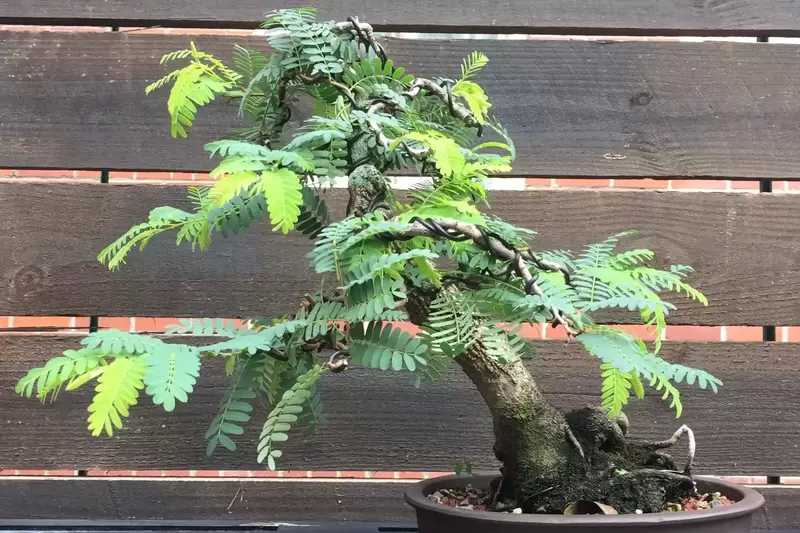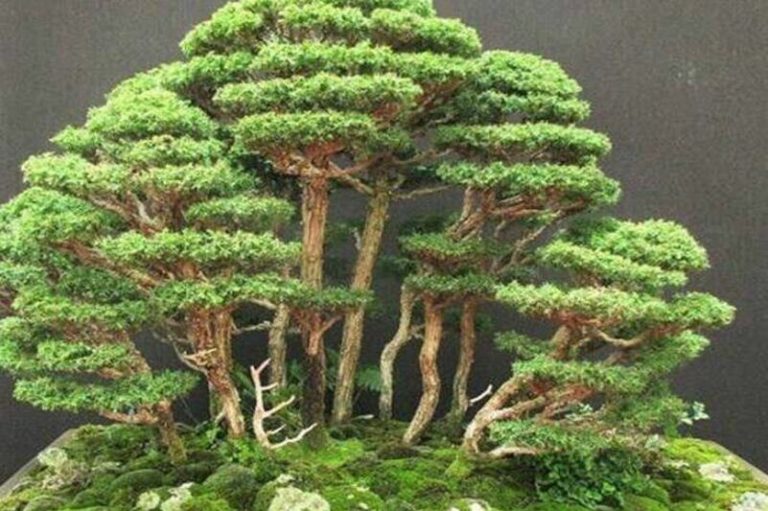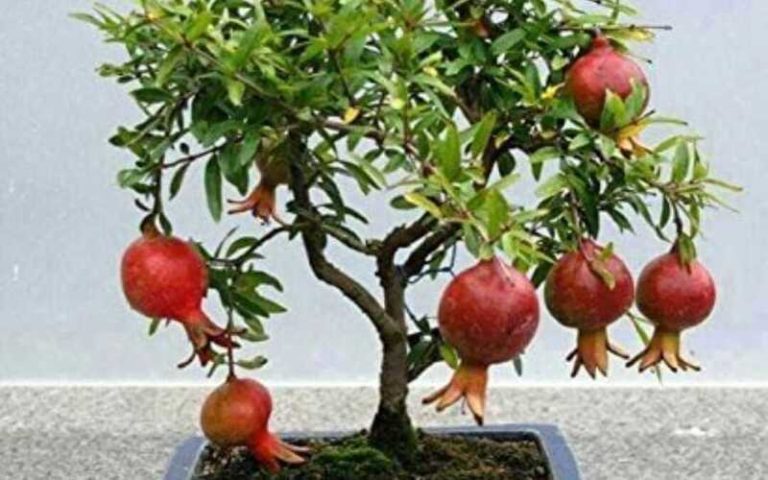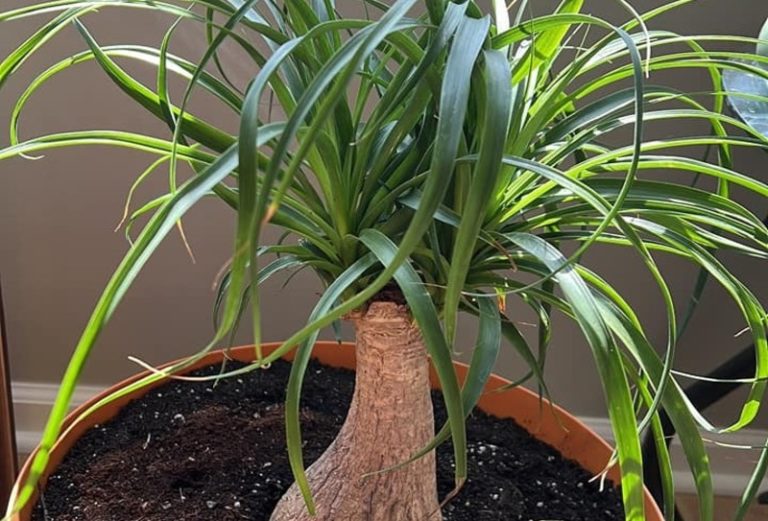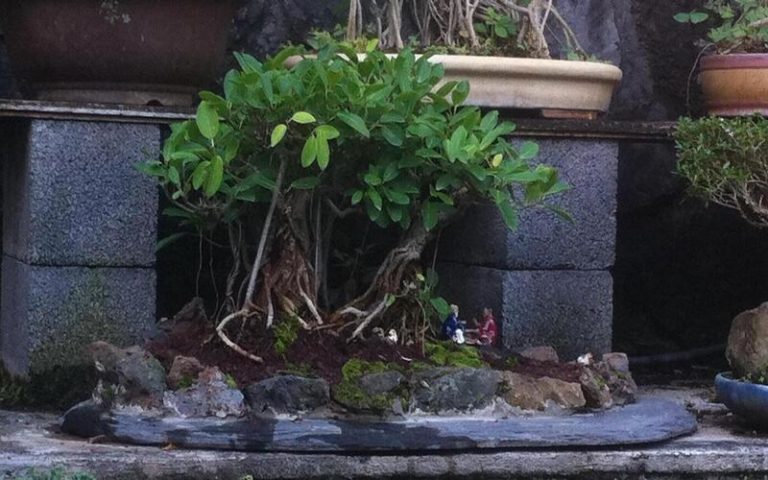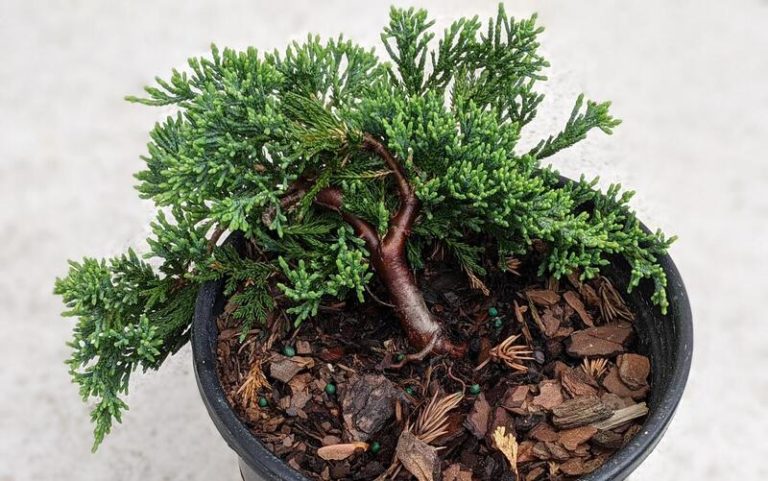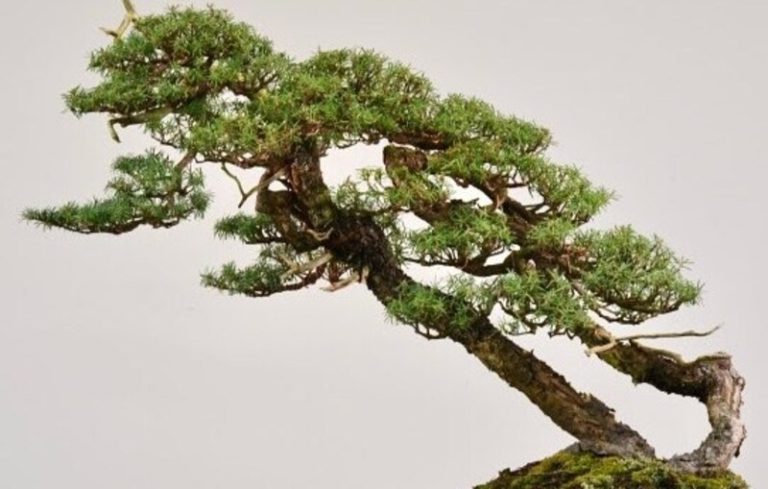Bonsai Tamarind: Unlocking the Secrets of its Ancient Origins
Bonsai trees are interesting tiny versions of full-sized trees that have won the hearts of many gardeners. One interesting choice is the miniature tamarind tree. In this article, we’ll talk about the beauty and attraction of bonsai tamarind and show you how to grow and care for this amazing tree.
What is a Bonsai Tamarind?
A bonsai tamarind is a small version of the tamarind tree cultivated through the art of bonsai. It is known for its delicate foliage and unique trunk structure. Bonsai tamarind trees are visually appealing and can be grown indoors. They may also have cultural and symbolic significance. Taking care of a bonsai tamarind involves proper soil, pruning, watering, and providing suitable sunlight and temperature conditions. It is a way to create a miniature living masterpiece that brings beauty and serenity to any space.
History and Origins of the Bonsai Tamarind
The background and roots of the bonsai tamarind can be traced back to the art of bonsai, which started in China more than a thousand years ago. Growing and shaping tiny trees as a form of art finally spread to Japan, where it became deeply rooted in their culture.
The tamarind tree (Tamarindus indica) is native to tropical Africa, but it has been widely grown and naturalized in many areas of the world, including Asia. As bonsai gardening became more popular in Japan, fans began experimenting with different tree species to create distinctive and fascinating bonsai specimens. The tamarind tree drew their interest owing to its particular traits and aesthetic appeal.
Over time, bonsai artists and gardeners discovered the potential of tamarind trees for bonsai cultivation. They started training and shaping tamarind trees using bonsai techniques such as pruning, wiring, and careful root development. Through years of cultivation and refinement, the art of growing bonsai tamarind trees evolved, resulting in the creation of stunning miniature versions of this tropical tree.
Bonsai tamarind trees are now widely available outside of Japan, in countries where the practice of bonsai has gained popularity. Bonsai collectors and fans have taken a like to them because of their interesting appearance, cultural relevance, and difficult cultivation.
The natural beauty and elegance of the tamarind tree in small form are celebrated through the history and origins of bonsai tamarind, which exemplify the rich heritage and continual creativity within the art of bonsai.
Bonsai Tamarinds and Their Symbolism
Bonsai tamarind trees hold symbolism that varies across different cultures and regions. Here are a few symbolic meanings associated with bonsai tamarind:
1. Wisdom and Longevity: Some cultures look up to the tamarind tree as a sign of wisdom and long life. People respect and try to be like it because it lives for a long time and can survive in harsh situations. Growing a tamarind tree can be seen as a way to show these things.
2. Patience and Perseverance: To grow a bonsai tree, you have to be patient and persistent, because it takes time and care to shape and train a tamarind tree into a small form. The slow and careful way that bonsai are made shows how important patience and persistence are in life.
3. Natural Beauty and Harmony: People like tamarind bonsai trees because they look nice and remind them of how beautiful nature is. They show how people and the wild world can work together in peace. The careful shaping and trimming methods used to grow bonsai are meant to create a balance between the way the tree grows naturally and how the artist wants it to look.
4. Cultural Significance: In places where tamarind has a special place in culture, bonsai tamarind trees can be a way to show cultural history and practices. They might remind you of how tamarind was used in food, as a medicine, or in holy ceremonies. Growing tamarind as a tree can help people connect with their cultural roots and keep traditional values alive.
5. Tranquility and Serenity: Like most bonsai, mango bonsai are often linked with a calm and peaceful feeling. The tree’s small size and beautiful shape can create a peaceful atmosphere, bringing a bit of nature inside and helping people feel calm and relaxed.
The symbolism of bonsai tamarind ultimately depends on personal beliefs, cultural context, and individual interpretations. Each bonsai enthusiast may find their own personal meaning and connection with these beautiful miniature trees.
Characteristics of the Bonsai Tamarind
Bonsai tamarind trees possess several distinctive characteristics that make them a fascinating choice for bonsai cultivation. Here are some key features of bonsai tamarind:
Delicate Foliage: The leaves of the tamarind tree are small and pinnate, typically consisting of multiple leaflets arranged along a central stem. In the bonsai form, these leaves are further reduced in size, creating a delicate and intricate foliage structure. The foliage can be a vibrant green, adding to the visual appeal of the bonsai tamarind.
Unique Trunk Structure: The base of a bonsai tamarind is known for its unique form and texture. With careful trimming and training, the trunk can grow twists, bends, and rough bark over time, just like the trunks of mature tamarind trees in nature. The trunk adds to the general beauty of the bonsai because of its structure and character.
Petite Size: Bonsai tamarind trees are grown to stay small and close together. They are much smaller than their full-sized counterparts and usually range in height from a few inches to a few feet, based on their age and stage of growth. Because bonsai tamarinds are small, they can be grown indoors. This means that fans can enjoy their beauty in small areas.
Drought Tolerance: Tamarind trees, including bonsai tamarind, have natural adaptations that enable them to tolerate periods of drought. They can survive in relatively dry conditions, making them suitable for bonsai enthusiasts who may have challenges maintaining consistent watering schedules. However, it is important to provide adequate water and hydration to ensure the health and vitality of the tree.
Seasonal Flowering and Fruit: When tamarind trees get old, they make pretty flowers and fruits that you can eat. Even though bonsai tamarind may not bear fruit because they are so small, they can sometimes make beautiful flowers when the time is right. These flowers can add to the beauty and charm of the bonsai tree in another way.
Overall, the delicate foliage, unique trunk structure, petite size, drought tolerance, and potential for seasonal flowering make bonsai tamarind trees captivating and sought-after specimens among bonsai enthusiasts. Their distinctive characteristics contribute to their aesthetic appeal and the rewarding experience of growing and caring for these miniature living works of art.
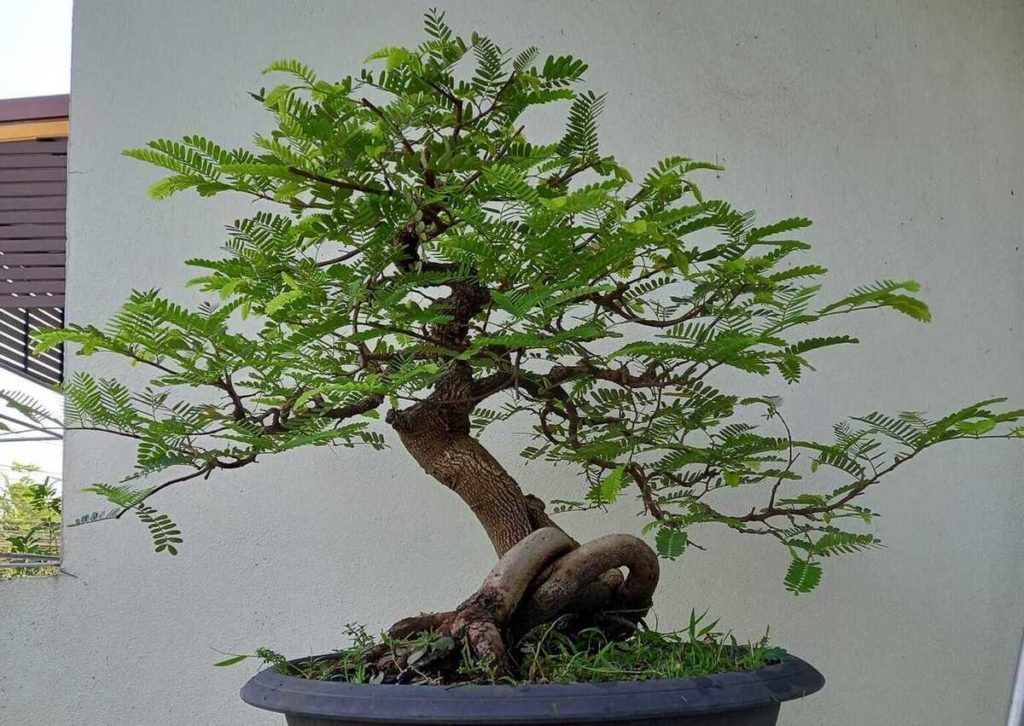
Types of Bonsai Tamarind
There are a few different kinds of tamarind trees that can be used to grow bonsai. Here are some common bonsai tamarind types:
- Tamarindus indica: This is the type of tamarind that is grown most often and is often used for bonsai. It has small, pinnate leaves and beautiful yellow flowers. The flowers are followed by pods that can be eaten and have tamarind pulp inside. Tamarindus indica is known for being hardy and for being easy to grow as a bonsai.
- Tamarindus indica ‘Improved’: This particular strain of Tamarindus indica is known for having better fruit quality and more fruit. It is like the standard Tamarindus indica in some ways, but in other ways it is better.
- Tamarindus indica ‘Golden’: This cultivar is valued for its golden or yellowish foliage. The leaves of the ‘Golden’ variety add a unique and striking color contrast to the bonsai tamarind tree, making it an attractive choice for enthusiasts looking for something different.
- Tamarindus indica ‘Variegated’: This type has leaves with patches of different colors, like green and yellow or green and cream. The bonsai tamarind tree looks interesting and unique because its leaves are different colors.
It’s crucial to remember that the availability of certain tamarind kinds for bonsai culture varies based on your area and nursery stock availability. Consider the required qualities, such as leaf size, trunk form, and general growth habit, when choosing a tamarind tree for bonsai to locate a type that matches your tastes.
Regardless of the specific variety chosen, all bonsai tamarind trees require proper care and cultivation techniques to thrive and maintain their unique features.
How to Grow a Bonsai Tamarind
Growing bonsai tamarind necessitates close attention and the use of suitable growing techniques. Here’s how to cultivate a bonsai tamarind step by step:
1. Selection of a Tamarind Tree: Choose a tamarind tree that is healthy and good for bonsai. Look for a young tree with good qualities, like small leaves, an interesting stem shape, and a nice overall look. Think about the kind of tamarind that works best for bonsai.
2. Potting and Soil: Use a well-draining bonsai soil mix that allows water to flow freely. The soil mix should consist of components like akadama, pumice, and lava rock. Repot the tamarind tree into a bonsai pot, ensuring proper drainage holes are present. Repotting is usually done in the early spring.
3. Pruning and Shaping: To keep the bonsai tamarind in the shape and size you want, you have to prune it often. Trim the branches, leaves, and root system carefully with sharp bonsai trimming shears. Pruning helps the bonsai grow into the shape you want, encourages spreading, and keeps it looking small.
4. Wiring and Training: Wiring is often used to form and direct how the stem and branches grow. Wrap bonsai wire around the branches and bend them gently into the position you want. Be careful not to hurt the stems or stop them from growing as they should. Wire scars can be avoided by adjusting the wires as needed.
5. Watering: For the bonsai tamarind to stay healthy, it needs to be watered the right way. Give the tree a lot of water until it runs out of the holes. To avoid overwatering, let the soil get just a little bit dry between watering. Change how often you water the tree based on the weather and how much water it needs.
6. Sunlight and Temperature: Bonsai tamarind trees do best in warm, tropical climates. Place the tree in a spot where it can get plenty of sunshine, especially in a spot that gets some shade during the hottest part of the day. Protect the tree from high temperatures, especially cold or freezing weather.
7. Fertilization: Regular fertilizer is important to give plants the nutrients they need for good growth. Use a balanced, slow-release bonsai fertilizer or an organic fertilizer made especially for bonsai trees. Follow the dosage and use directions given by the maker.
8. Pest and Disease Control: Check the bonsai tamarind often for signs of diseases or pests. Aphids, mealybugs, and spider mites are common pests that can hurt tamarind trees. If there are bugs, use sprays or treatments that kill insects to get rid of them. Keep your cleanliness in good shape and take care of any signs of disease or bacteria right away.
9. Maintenance and Care: Remove any dead or yellowing leaves from the bonsai tamarind, keep the wires in good shape, and repot the plant every so often to refresh the soil and encourage healthy root growth. Cut the tree back and shape it as needed to keep it the size and shape you want.
Remember that bonsai cultivation is an ongoing process that requires patience, observation, and dedication. Understanding the specific needs of your bonsai tamarind and providing appropriate care will help ensure its healthy growth and the development of a stunning miniature tree over time.
Benefits of the Bonsai Tamarind
The bonsai tamarind tree offers several benefits, both aesthetic and practical, for enthusiasts who choose to cultivate it. Here are some of the benefits of growing bonsai tamarind:
Aesthetic Appeal: The bonsai tamarind tree is visually captivating and adds natural beauty to any space. Its delicate foliage, unique trunk structure, and overall miniature form create an aesthetically pleasing display. The bonsai tamarind can serve as a focal point, enhancing the visual appeal of indoor or outdoor environments.
Space Efficiency: Bonsai tamarind trees are small in size, making them suitable for cultivation in limited spaces. Their compact nature allows enthusiasts to enjoy the beauty of a tree even in small apartments, offices, or balconies. Bonsai tamarind provides an opportunity for those with space constraints to connect with nature and experience the joy of growing a tree.
Therapeutic and Stress-Relieving: Caring for a bonsai tamarind tree may be a contemplative and relaxing activity. The care, trimming, and shape of the tree encourages focus and relaxation. Many individuals believe that caring for bonsai trees is a therapeutic pastime that helps them relax and feel better.
Cultivation of Patience and Discipline: Growing a bonsai tamarind tree requires patience, discipline, and attentiveness. The slow growth rate of the tree and the meticulous care it demands teach enthusiasts valuable lessons in patience, discipline, and appreciation of the natural world. Bonsai cultivation can be a rewarding hobby that fosters personal growth and character development.
Connection to Nature: Even in metropolitan areas, bonsai tamarind trees give a chance to connect with nature. Bringing a real tree within or having a bonsai tamarind on a balcony lets people to feel the peace and beauty of nature in their daily lives. It may be an inspiration and a reminder of the balance that exists between humans and the natural world.
Cultural and Symbolic Significance: In some countries, tamarind is a culturally and symbolically important thing. Growing a tamarind tree can be a way to show respect for and connect with these customs. It can also be a way to start a talk and teach others about your culture.
Educational Value: Cultivating a bonsai tamarind tree allows you to learn about the biology, horticulture, and creativity involved in bonsai growth. It encourages people to learn about the methods, history, and care practices involved with bonsai. It may be a rewarding and life-long learning experience.
Overall, the bonsai tamarind tree offers a range of benefits, from its visual appeal and space efficiency to its therapeutic qualities and educational value. It brings a touch of nature, beauty, and serenity into the lives of those who appreciate its unique charm.
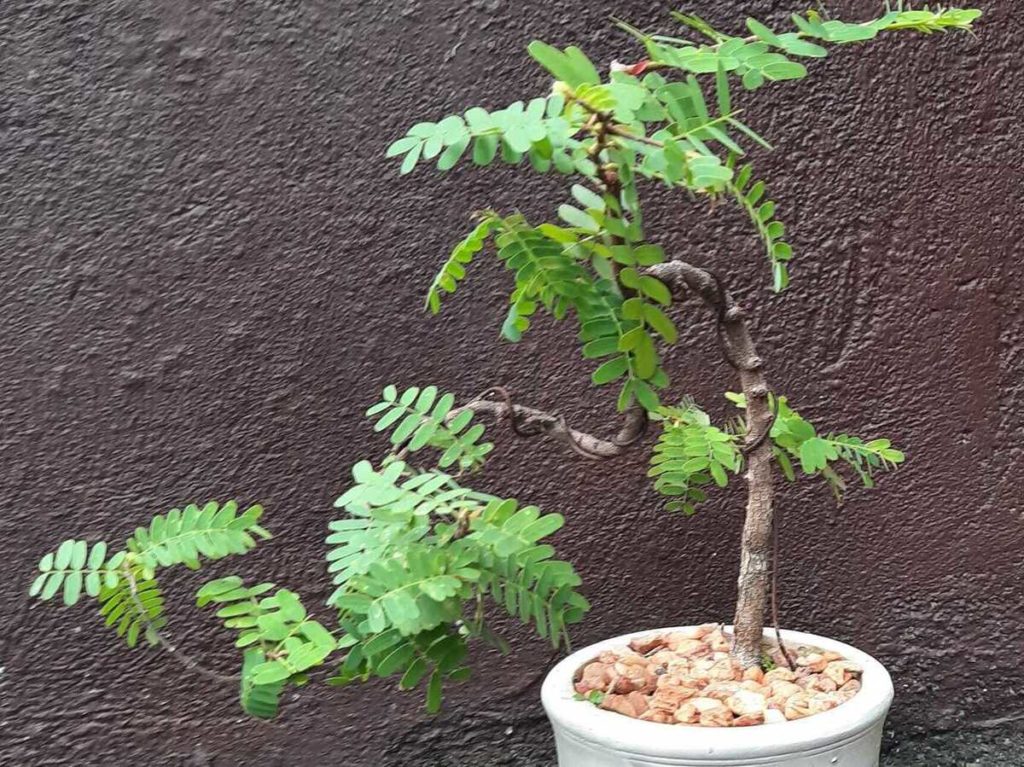
Displaying and Showcasing the Bonsai Tamarind
Displaying and showcasing a bonsai tamarind tree can be an art in itself. Here are some tips to effectively present and highlight the beauty of your bonsai tamarind:
- Choosing the Right Display Stand: Select a suitable display stand that complements the overall aesthetic of your bonsai tamarind. Options include traditional wooden stands, stone slabs, or metal stands. The stand should provide stability and elevate the bonsai to a comfortable viewing height.
- Consider the Background: Choose an appropriate backdrop that enhances the bonsai’s visual impact. A solid-colored wall, a neutral-colored screen, or a natural setting can create a visually pleasing contrast and draw attention to the bonsai tamarind.
- Placement and Lighting: Position the bonsai tamarind in a well-lit area where it can receive ample natural light. Indirect sunlight is generally preferred to avoid scorching the delicate foliage. Adjust the lighting to highlight the tree’s form, texture, and colors. Experiment with different angles and lighting conditions to find the most flattering presentation.
- Rotate the Display: Regularly rotate the position of the bonsai tamarind to ensure even growth and prevent one side from becoming overexposed or shaded. Rotating the tree also allows viewers to appreciate different angles and perspectives, enhancing their overall experience.
- Group Display: Consider showcasing the bonsai tamarind as part of a bonsai display group. Combining multiple bonsai trees or incorporating accent plants, rocks, or figurines can create a harmonious and visually appealing composition. Ensure that each element in the group complements and enhances the overall display.
- Presentation Materials: Utilize accent materials such as moss, decorative gravel, or small figurines to enhance the visual appeal of the display. These elements can add texture, color, and interest to the overall presentation. Ensure that these materials are clean and well-maintained.
- Exhibitions and Competitions: Participate in bonsai exhibitions and competitions to showcase your bonsai tamarind to a wider audience. Such events provide opportunities to connect with other bonsai enthusiasts, receive feedback, and gain recognition for your skill and artistry.
- Regular Maintenance: Keep your bonsai tamarind tree well-maintained by regularly pruning, wiring, and grooming. Ensure that the tree remains healthy and free from pests or diseases. A well-cared-for bonsai tamarind will enhance the overall presentation and attract attention.
Remember, displaying a bonsai tamarind is a personal and creative process. Experiment with different presentation techniques and find a style that aligns with your artistic vision and the unique characteristics of your bonsai tree.
Styling and Design of a Bonsai Tamarind
The styling and design of a bonsai tamarind tree are crucial in creating a visually appealing and balanced composition. Here are some styling techniques and design considerations for shaping your bonsai tamarind:
Determine the Bonsai Style: Choose a bonsai style that suits your artistic vision and the characteristics of the tamarind tree. Common styles for bonsai tamarind include formal upright (chokkan), slanting (shakan), cascade (kengai), and informal upright (moyogi). Each style has its own aesthetic and creates a different impression.
Trunk and Branch Structure: Develop an interesting and visually appealing trunk and branch structure. This can be achieved through careful pruning, wiring, and shaping techniques. Create movement and taper in the trunk, and position the branches in a way that creates balance and harmony. Avoid overly straight or symmetrical lines, as they can appear unnatural.
Branch Placement and Direction: Position the branches in a way that reflects the natural growth habit of the tamarind tree. Avoid the overcrowding of branches and ensure that each branch has enough space to develop. Vary the lengths and directions of the branches to create depth and visual interest.
Leaf Reduction: As the tamarind tree naturally has large leaves, leaf reduction techniques can be applied to achieve a more proportionate and refined appearance. Regularly prune and trim the leaves, promoting the growth of smaller and more compact foliage pads.
Negative Space: Consider the concept of negative space, which refers to the empty spaces between branches and foliage. Negative space helps create a sense of balance, openness, and simplicity in the design. Allow for some gaps between branches and foliage to enhance the overall aesthetic.
Root Placement: Pay attention to the placement and visibility of the root system. Expose some of the roots to add a sense of age and stability to the bonsai. Use root pruning techniques to refine and shape the root structure, ensuring it complements the overall design.
Overall Balance and Proportions: Aim for a well-balanced and proportionate design. The visual weight of the foliage and branches should be evenly distributed throughout the tree. Consider the overall height, width, and depth of the bonsai tamarind to achieve a pleasing and harmonious composition.
Naturalistic Appearance: Strive for a naturalistic appearance that mimics the growth patterns of a mature tamarind tree. Avoid excessive bending or contorting of branches that appears unnatural. The goal is to create a bonsai that appears as if it could exist in nature, despite its miniature size.
Remember that bonsai styling is a gradual process that takes time and patience. Regular maintenance, pruning, and training are essential to refine the design and achieve the desired aesthetic. Study and observe mature tamarind trees in their natural environment to gain inspiration and insight into their growth patterns.
How to Care for and Maintain a Bonsai Tamarind
Caring for and maintaining a bonsai tamarind tree is critical to its health, development, and longevity. Here are some important care instructions to follow:
- Watering: Watering your bonsai tamarind properly is critical to its health. Water the tree well, allowing it to soak through the soil and drain through the drainage holes. Overwatering or leaving the tree to linger in wet soil can cause root rot. Monitor soil moisture and adjust watering frequency based on the demands of the tree and the environment.
- Sunlight: Bonsai tamarind trees thrive in bright, indirect sunlight. Place your tree in a location where it can receive at least 4-6 hours of sunlight per day. If growing indoors, provide a well-lit spot near a window or use supplemental grow lights to ensure adequate light exposure.
- Temperature and Humidity: Bonsai tamarind trees prefer warm temperatures between 65 and 85°F (18 and 29°C). Protect the tree from extreme temperature fluctuations, drafts, and frost. Maintain moderate humidity levels around the tree by misting the foliage or using a humidity tray filled with water and pebbles.
- Fertilization: Regular fertilization is necessary to provide essential nutrients for healthy growth. Use a balanced, slow-release bonsai fertilizer or an organic fertilizer specifically formulated for bonsai trees. Follow the manufacturer’s instructions regarding dosage and application frequency. Fertilize during the growing season (spring to early fall) and reduce or stop fertilization during the dormant period.
- Pruning and Trimming: Prune and trim your bonsai tamarind tree regularly to maintain its shape, promote branching, and control its size. Remove any dead, diseased, or damaged branches, and trim back excessive growth. Pruning also helps improve airflow and sunlight penetration throughout the tree.
- Wiring and Training: Use bonsai wire to shape and guide the branches of your tamarind tree. Wrap the wire gently around the branches, avoiding overtightening, to prevent damage. Adjust the wire as needed to achieve the desired shape, but avoid leaving the wire on for too long to prevent wire scars. Train the branches using gentle bending techniques.
- Soil and Repotting: Bonsai tamarind trees require well-draining soil to prevent waterlogging. Repot the tree every 2-3 years, preferably in early spring before new growth begins. Use a well-balanced bonsai soil mix or a mixture of akadama, pumice, and lava rock to ensure good drainage and aeration for the roots.
- Pest and Disease Control: Inspect your bonsai tamarind on a regular basis for pests like as aphids, mealybugs, and spider mites. If pests are prevalent, use insecticidal sprays or natural therapies to control them. To avoid the spread of fungal illnesses, keep your environment clean by removing fallen leaves and trash.
- Winter Care: Bonsai tamarind trees are sensitive to cold temperatures. Protect your tree from freezing conditions by moving it to a sheltered location or using insulation materials such as frost blankets or horticultural fleece. Reduce watering during the dormant period, but ensure the tree does not dry out completely.
- Regular Observation and Care: Monitor your bonsai tamarind regularly for any signs of stress, nutrient deficiencies, or pests. Pay attention to the health of the foliage, the appearance of new growth, and the overall vigor of the tree. Adjust your care routine based on the specific needs of your bonsai.
By following these care guidelines, you can maintain a healthy and thriving bonsai tamarind tree that will continue to bring you joy and beauty for years to come.
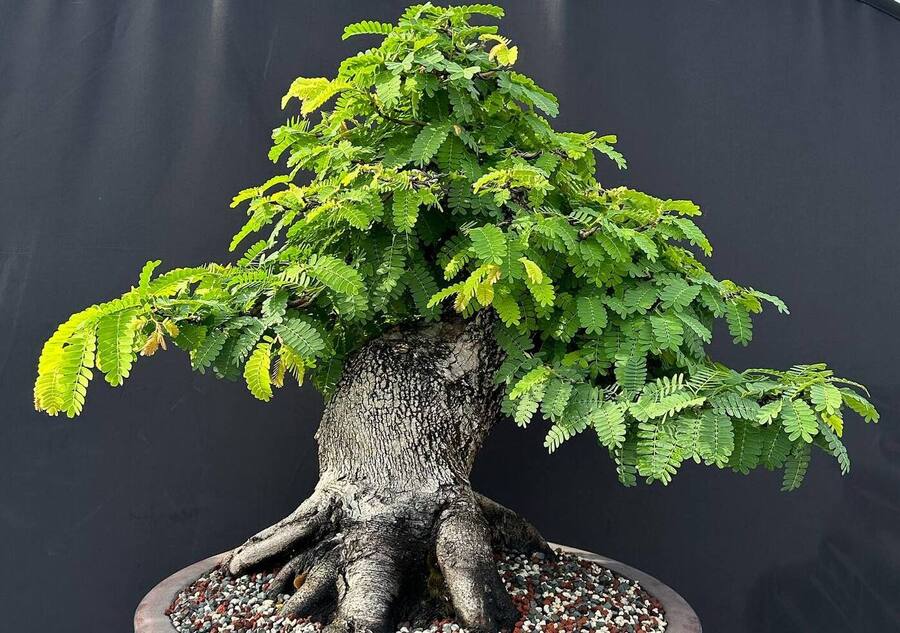
Bonsai Tamarind Care Sheet
| Aspect | Care Tips |
| Watering | Water thoroughly when the topsoil feels slightly dry. Avoid waterlogging. |
| Ensure proper drainage and do not let the tree sit in excess water. | |
| Sunlight | Place in bright, indirect sunlight. |
| Provide 4-6 hours of sunlight per day. | |
| Temperature | Keep in temperatures between 65-85°F (18-29°C). |
| Protect from extreme temperature fluctuations and frost. | |
| Humidity | Maintain moderate humidity levels. Mist the foliage or use a humidity tray with water. |
| Fertilization | Use balanced, slow-release bonsai fertilizer or organic fertilizer for bonsai. |
| Fertilize during the growing season; reduce or stop during dormancy. | |
| Pruning and Trimming | Regularly prune to maintain shape, remove dead/damaged branches, and control size. |
| Trim excessive growth for better airflow and light penetration. | |
| Wiring and Styling | Use bonsai wire to shape and guide branches. Avoid overtightening. |
| Train branches using gentle bending techniques. | |
| Repotting | Repot every 2-3 years in well-draining bonsai soil mix. |
| Repot in early spring before new growth starts. | |
| Pest and Disease Control | Regularly inspect for pests like aphids and spider mites. Treat with appropriate measures. |
| Maintain good hygiene by removing fallen leaves and debris. | |
| Winter Care | Protect from freezing temperatures. Move to a sheltered location or use insulation materials. |
| Reduce watering during dormancy, but do not let the tree dry out completely. | |
| Regular Maintenance | Observe the tree for signs of stress, nutrient deficiencies, or pests. |
| Adjust care routine based on specific needs and overall tree health. |
Remember that individual care requirements may vary depending on the specific environment and condition of your bonsai tamarind tree. Regular observation and adjustments are crucial for maintaining its health and beauty.
Conclusion
Bonsai tamarind trees offer gardeners a unique and interesting way to enjoy their hobby. By taking the important steps and giving this small tree the right care, you can enjoy its beauty. Learn how to grow bonsai and you can bring the beauty of nature into your home in a beautiful way.
FAQ:
Q: What is a Bonsai Tamarind?
A: Bonsai tamarinds are small versions of the tamarind tree (Tamarindus indica) that are grown and trained in a small pot. It is a live work of art that shows the beauty and spirit of a full-sized tree in a small size.
Q: How small can a bonsai tamarind be?
A: Tamarind bonsai trees can be different sizes, but they are usually kept small, between a few inches and a couple of feet tall. The size varies on how old the tree is and what style and look you want.
Q: Can bonsai tamarind trees produce fruit?
A: Yes, bonsai tamarind trees have the potential to produce fruit under the right conditions. However, it can be challenging to achieve fruiting in a bonsai setting due to the tree’s size constraints and the need for optimal growing conditions.
Q: How long does a bonsai tamarind live?
A: A bonsai tamarind tree can live for decades or even longer if it is taken care of well. A miniature tamarind will live about the same amount of time as a full-sized one.
Q: Do bonsai tamarind trees require special care?
A: Yes, bonsai tamarind trees require specific care to thrive. They need regular watering, proper sunlight exposure, pruning to maintain their shape, fertilization, and protection from extreme temperatures. Understanding and meeting their specific care needs is essential for their health and longevity.
Q: Can I keep a bonsai tamarind indoors?
A: While bonsai tamarind trees can be temporarily kept indoors, they are best suited for outdoor growing. They require sufficient sunlight and airflow, which can be challenging to provide indoors. If kept indoors, it is essential to place them near a well-lit window or provide supplemental grow lights.
Q: Can I create my own bonsai tamarind from a seed or cutting?
A: Yes, you can create your own bonsai tamarind tree from a seed or cutting. Growing a bonsai from a seed will require more time and patience, while using a cutting can accelerate the process. Proper techniques such as scarification, germination, and nurturing are needed to ensure successful growth.
Q: Can I style my bonsai tamarind in different shapes and forms?
A: Yes, bonsai tamarind trees can be styled in various forms and shapes, such as formal upright, slanting, cascade, or informal upright. The styling process involves careful pruning, wiring, and training techniques to shape the tree according to your artistic vision and the natural characteristics of the tamarind tree.
Q: Can I display my bonsai tamarind tree indoors?
A: While bonsai tamarind trees are typically best suited for outdoor display, you can temporarily showcase them indoors for short periods. However, ensure they receive adequate sunlight and proper care. Regularly rotate them outdoors to provide them with the ideal growing conditions they require.
Q: How often should I water my bonsai tamarind?
A: The frequency of watering depends on various factors such as climate, pot size, and tree size. As a general guideline, water the bonsai tamarind thoroughly when the topsoil feels slightly dry. Avoid overwatering, as it can lead to root rot. Monitor the moisture levels of the soil and adjust the watering schedule accordingly.
Q: How often should I fertilize my bonsai tamarind?
A: Bonsai tamarind trees benefit from regular fertilization during the growing season (spring to early fall). Use a balanced, slow-release bonsai fertilizer or an organic fertilizer specifically formulated for bonsai. Follow the instructions provided by the manufacturer regarding dosage and application frequency.
Q: Can I trim the roots of my bonsai tamarind?
A: Yes, root trimming is an important part of bonsai care. It helps keep the tree healthy and lets the roots grow in the right way in the limited room of the bonsai pot. Root trimming is usually done when repotting, which should be done every 2–3 years.
Q: How do I prevent pests and diseases in my bonsai tamarind?
A: Regularly inspect your bonsai tamarind for pests such as aphids, mealybugs, and spider mites. Treat any infestations with appropriate insecticidal sprays or natural remedies. Maintain good hygiene by removing fallen leaves and debris, as they can harbor pests and promote disease. Proper care practices, including proper watering and adequate sunlight, can also help keep the tree healthy and more resistant to pests and diseases.
Q: Can I shape and wire the branches of my bonsai tamarind at any time?
A: It is generally recommended to shape and wire the branches of your bonsai tamarind during the tree’s active growth period, typically in spring or early summer. This allows the tree to recover and adjust to the new shape before entering the dormant period. Avoid wiring or heavy pruning during the winter dormancy period.
Q: What should I do if my bonsai tamarind loses leaves?
A: Leaf loss in a bonsai tamarind can be a sign of stress or inadequate care. Check the watering, sunlight, and temperature conditions to ensure they are within the tree’s preferred range. Adjust your care routine accordingly. If the leaf loss persists or is accompanied by other signs of distress, it is advisable to consult with a bonsai expert or horticulturist for further assistance.
Q: Can I repot my bonsai tamarind anytime I want?
A: Bonsai tamarind trees should be repotted every 2-3 years, ideally in early spring before new growth starts. Repotting at the right time allows the tree to recover quickly and take advantage of the growing season. Repotting at other times may cause unnecessary stress to the tree, so it’s best to follow the recommended repotting schedule.
Also Read:

